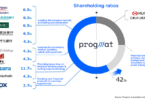Rhomaios Ram, the CEO of Fnality, plans to step down, Bloomberg reported. He will remain in his role until the board finds a replacement. Fnality is the payment system backed by 20 global institutions, including BNP Paribas, BNY, the DTCC, Goldman Sachs, Santander, State Street and UBS.
The company launched its Sterling Fnality Payment System last year. It’s designated as a systemically important payments firm, and hence is under the watchful eye of the Bank of England, which has to approve each new use case. Fnality UK has its own CEO, Angus Fletcher. However, there are plans to support multiple currencies, particularly the US dollar and Euro.
It has taken a long time to get to this stage. Ram has been CEO since incorporation in 2019, but Fnality evolved from the Utility Settlement Coin initiative, which started in 2016.
The company’s most recent funding round was announced a year ago when it raised a £77.7 million ($97m) Series B, following a £50 million ($62m) Series A in 2019. The company lost around £26 million ($33m) in each of the past two years and had £40 million in cash remaining at the end of 2023. So it’s probably time for work on another funding round.
An elegant DLT payment solution
While Fnality disavows the label, the tokenized payment instrument is like a higher quality institutional stablecoin. The token is backed by funds held in an omnibus bank account at the Bank of England. Institutions transfer money from their central bank account to the omnibus account to mint tokens. Unlike typical tokenized deposits where each bank has a separate coin, Fnality is a shared token that’s ideal for interbank payments. It’s what the IMF would refer to as a synthetic CBDC.
There’s nothing else like it in the world. The SIX Digital Exchange launched a synthetic CBDC but that just involved SIX, rather than many institutions. While the UK likes to think of itself as a fintech innovation hub, Fnality is the living proof. That’s provided that banks take full advantage of it.
A key advantage of tokenized cash is it could be used for 24/7 instant payments, provided the institution has already minted tokens during RTGS operating hours. Hence, it can support intraday repo, intraday margin calls or it can settle other on-chain transactions for securities. It has the potential to save banks many tens of millions.
Typical tokenized deposit solutions, where banks have separate coins, require interbank settlement, and Fnality can play that role in the absence of a wholesale CBDC. It was discussed as part of the recent UK Regulated Liability Network trials, although no technical integration was made.
For institutions, DLT has a few killer apps, with three being cross border payments, collateral mobility and intraday transactions. While Fnality can play a role in the latter two, for cross border payments it ideally needs another currency or two.
If it launched other currencies, it would be an elegant solution for FX PvP. And FX risks are something that worries central banks. Hence, one would think they’d be keen to support Fnality in addressing the risks.
Three key roles of the new CEO are expanding currencies, funding and wrangling the 20 institutional backers.
Fnality in the US?
With the DTCC as one of its backers, Fnality couldn’t have a bigger ally stateside. The question is whether a Trump government will work for or against it. It has made a little progress Stateside during the past year.
CBDC is a non starter for Republicans. They tend to lump wholesale CBDC with retail, even though wholesale should not have the same privacy issues. Hence, this could favor the adoption of a private, synthetic CBDC solution such as Fnality. If it launched in the United States, it always planned a local subsidiary.
While central banks frown upon stablecoins for institutional settlement, there’s a possibility that the incoming administration might not. After all, Trump is close to Howard Lutnick of Cantor Fitzgerald, which manages Tether’s stablecoin reserves. That would mean competition for Fnality. Hence, it remains to be seen whether the Trump administration represents an opportunity or a challenge for Fnality. In the United States, Fnality might want to embrace the label of institutional stablecoin.
Fnality could face challenges on home turf. For a couple of years, it seemed unlikely the UK would issue a wholesale CBDC given Fnality existed. However, that stance appears to have changed, so Fnality could have competition from the State at home. This is a double whammy. Because the prospect of a possible wCBDC could be an excuse for banks to drag their feet in embracing Fnality, which would be a mistake.
Fnality in the EU?
Europe is coming to the end of its wholesale DLT settlement trials in central bank money, which have had impressive engagement, particularly in Germany. However, all three Eurosystem solutions were managed by central banks, including the French one which offered a wholesale CBDC. Fnality has done presentations to the European Central Bank (ECB) group but not been directly involved in the trials.
Given the ECB uses the foreign ownership of Visa and Mastercard as a justification for a retail digital euro, it might not be keen if the ultimate owner of a synthetic CBDC is based outside the EU.
Fnality has always targeted backing its token with central bank money. That’s its biggest strength but also the reason it took so long to launch in the UK. And it’s why it hasn’t yet launched other currencies. There are some obvious workarounds to address this.
Those potential workarounds and other topics around cross border payments and tokenized deposits are explored in a new report released by Ledger Insights.






